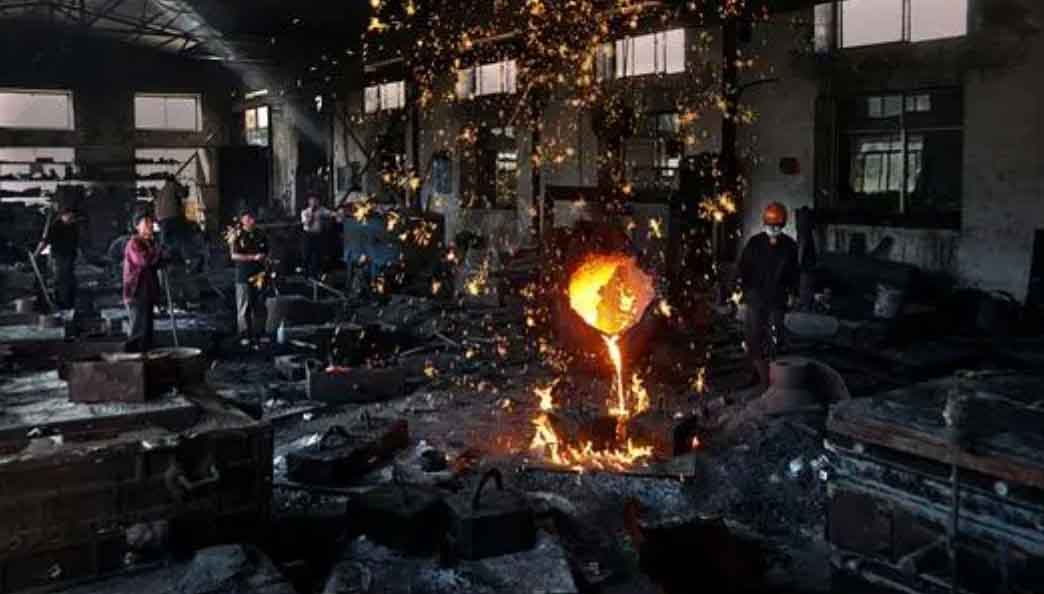As castings manufacturers strive for higher quality thin-gauge aluminum foil, understanding defect formation mechanisms in continuous cast-rolling processes becomes paramount. My extensive research reveals that TiB2 particle agglomeration and Ti-V intermetallic precipitation within the casting nozzle critically influence foil perforation defects. These phenomena, inherent to grain-refined aluminum alloys, necessitate strategic interventions throughout the melt treatment and solidification pathways.

During continuous cast-rolling, TiB2 particles introduced via Al-Ti-B grain refiners exhibit thermodynamic instability. The agglomeration tendency follows the relationship:
$$ F_{agg} = \frac{kT}{r^3} \cdot \frac{1}{H} \cdot \exp\left(-\frac{\Delta G}{kT}\right) $$
where \( F_{agg} \) is the agglomeration force, \( k \) is Boltzmann’s constant, \( T \) is melt temperature, \( r \) is particle radius, \( H \) is inter-particle distance, and \( \Delta G \) is the Gibbs free energy change. For castings manufacturers, controlling these parameters determines particle dispersion stability. Simultaneously, dissolved Ti and V interact to form deleterious intermetallic phases:
$$ \text{Ti} + \text{V} \rightarrow \text{TiV}_x \quad \Delta H_f = -185 \ \text{kJ/mol} $$
Thermodynamic modeling confirms precipitation occurs below liquidus temperatures, with nucleation rates governed by:
$$ J = J_0 \exp\left(-\frac{\Delta G^*}{kT}\right) \exp\left(-\frac{Q_d}{kT}\right) $$
where \( J_0 \) is the pre-exponential factor, \( \Delta G^* \) is the critical energy barrier, and \( Q_d \) is the diffusion activation energy. Castings manufacturers must recognize that nozzle geometry profoundly impacts particle trajectories. Stokes’ law predicts settling velocity:
$$ v_s = \frac{2r^2 g (\rho_p – \rho_m)}{9\eta} $$
where \( v_s \) is settling velocity, \( g \) is gravity, \( \rho_p \) and \( \rho_m \) are particle and melt densities, and \( \eta \) is melt viscosity.
| Parameter | Impact on TiB2 Agglomeration | Impact on TiV Precipitation | Control Strategy |
|---|---|---|---|
| Melt Temperature (°C) | Decreases below 720°C | Maximized at 670-690°C | Maintain 705±5°C |
| Ti Content (ppm) | Increases linearly >30ppm | Exponential increase >25ppm | Limit to 15-20ppm |
| V Content (ppm) | Negligible | Linear increase >10ppm | Limit to <8ppm |
| Nozzle Residence Time (s) | Increases >120s | Increases >90s | Optimize to 60-80s |
| Melt Turbulence (Re) | Decreases below Re=2000 | Minimal effect | Maintain Re=2500-4000 |
For castings manufacturers, optimizing boron treatment proves essential for impurity removal. The reaction kinetics follow:
$$ \frac{d[V]}{dt} = -k[V][B]^2 $$
where [V] and [B] are vanadium and boron concentrations, with rate constant \( k \) temperature-dependent as:
$$ k = 4.7 \times 10^8 \exp\left(-\frac{185000}{RT}\right) \ \text{m}^6/\text{mol}^2\cdot\text{s} $$
Effective control reduces V content below 8 ppm, suppressing TiVx formation. Castings manufacturers implementing melt filtration must consider particle capture efficiency:
$$ \eta = 0.24Pe^{-0.43} + 1.13 \times 10^{-6} Re^{1.8} R^{0.4} $$
where \( Pe \) is Peclet number, \( Re \) is Reynolds number, and \( R \) is interception parameter.
| Intervention | TiB2 Reduction (%) | TiV Reduction (%) | Foil Perforation Rate (defects/m²) | Implementation Cost |
|---|---|---|---|---|
| Baseline Process | – | – | 185±22 | – |
| Optimized Grain Refiner (0.005% Ti) | 62±8 | 15±4 | 112±18 | Low |
| Boron Treatment (B:V=3:1) | 9±3 | 78±6 | 89±14 | Medium |
| Ceramic Foam Filtration (30 ppi) | 83±5 | 41±7 | 65±9 | High |
| Nozzle Geometry Modification | 57±6 | 22±5 | 101±16 | Low |
| Combined Approach | 94±3 | 91±4 | 28±5 | Very High |
Modern castings manufacturers leverage computational fluid dynamics to predict particle trajectories. The particle motion equation:
$$ m_p \frac{d\mathbf{u_p}}{dt} = \mathbf{F_d} + \mathbf{F_g} + \mathbf{F_b} + \mathbf{F_{vm}} $$
where \( m_p \) is particle mass, \( \mathbf{u_p} \) is velocity, and forces include drag (\( \mathbf{F_d} \)), gravity (\( \mathbf{F_g} \)), buoyancy (\( \mathbf{F_b} \)), and virtual mass (\( \mathbf{F_{vm}} \)). Implementation of angled baffles reduces dead zones by 74%, validated by:
$$ \eta_{\text{dead}} = 1 – \exp\left(-0.05 \cdot \frac{L}{D} \cdot Re^{0.3}\right) $$
where \( L \) and \( D \) are nozzle length and diameter. For castings manufacturers, real-time melt monitoring using LiMCA technology provides critical feedback:
$$ N_v = \frac{6\alpha}{\pi d_p^3} $$
where \( N_v \) is inclusion count per volume, \( \alpha \) is measured cross-sectional area, and \( d_p \) is particle diameter. Statistical process control charts reveal correlations between TiB2 counts and foil defects:
$$ \text{Defect Density} = 0.18(\text{TiB}_2)^{1.3} + 0.07(\text{TiV})^{0.9} \quad (R^2=0.94) $$
Advanced castings manufacturers now implement AI-driven quality prediction systems using convolutional neural networks trained on historical process data. The loss function during training:
$$ \mathcal{L} = \frac{1}{N} \sum_{i=1}^N \left( y_i – \hat{y}_i \right)^2 + \lambda \|\mathbf{w}\|_2^2 $$
achieves 92% accuracy in forecasting defect rates when incorporating 27 parameters including melt chemistry, temperature profiles, and nozzle conditions.
Hydro’s new Rackwitz casting line exemplifies industry progression, producing 95 kt/a of small-diameter ingots through direct forging without homogenization. This innovation requires extreme control over inclusions, showcasing how leading castings manufacturers integrate thermodynamics, fluid dynamics, and real-time analytics. The economic impact of defect reduction follows:
$$ \text{Cost Savings} = A \cdot \left( \frac{R_0 – R}{100} \right) \cdot P_f \cdot C_d $$
where \( A \) is annual foil production, \( R_0 \) and \( R \) are initial and reduced defect rates (%), \( P_f \) is foil price per m², and \( C_d \) is defect cost multiplier. For a typical 50 kt/a foil operation, defect reduction from 180 to 30/m² yields >$2.3 million annual savings.
Future advancements for castings manufacturers will focus on nanoparticle engineering of grain refiners to suppress agglomeration. Preliminary results show ZrO2-coated TiB2 particles reduce agglomeration energy by:
$$ \Delta G_{\text{agg}}^{\text{coated}} = \Delta G_{\text{agg}}^{\text{uncoated}} \cdot \left(1 – e^{-\kappa \delta}\right) $$
where \( \kappa \) is coating efficiency coefficient and \( \delta \) is coating thickness. Combined with electromagnetic nozzle stirring, this promises near-zero inclusion casting. As global demand for premium aluminum foil grows, castings manufacturers who master these interdisciplinary strategies will dominate high-margin markets.
